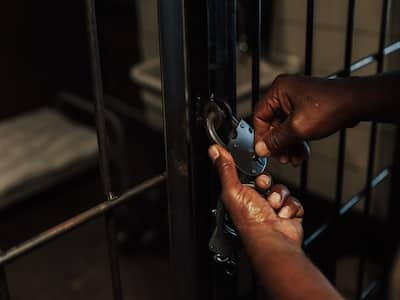
The work experiences of the seasoned psychiatrist also include cases of national importance like the Nirbhaya Rape Case (2012) and the Butcher of Delhi (2007).
The relationship between mental illness and criminal behaviour has always been the topic of intense debate and scrutiny among experts. There is an existing notion that people with mental illness are more prone to acts of violence and aggression. However, criminal behaviour is not indicative of mental illness. This is why it is not clinically treated. Some criminals might be motivated to engage in anti-social behaviour due to underlying psychological problems. Some mental illnesses and criminality, both, can reflect a loss of impulse control and a lack of inhibition in some circumstances. However, the two cannot be taken for one. In other words, criminal behaviour is a social concern with complex underlying causes.
Illegal conduct can also stem from the loss of inhibition caused by some substances like alcohol or drugs. As per experts, the courtroom scene where a criminal masks his wrong-down within the garb of mental illness is a common sight. It can also be another way around where a mentally ill person could engage in a violent act as a consequence of their disease. In other words, the boundary between mental illness and criminal intent can be blurry at times. As per experts, establishing a relationship between mental illness and crime is a difficult task.
To understand the complex correlation between the two, Health site spoke to Dr Vivek Rustagi, Head of the Department of Psychiatry and in charge of the mental health unit in Delhi prisons (Tihar and Mandoli). The work experiences of the experienced psychiatrist also include cases of national importance like the Nirbhaya Rape Case (2012) and the Butcher of Delhi (2007).
The expert elaboratively explained the delicate boundary between violent behaviour induced by mental illness and a criminal act performed with an established intent.
We would like to explore the blurred boundary between mental illness and criminality. It is common for us to hear courtroom stories and follow case studies where immoral behaviour is tactfully garbed within the insanity. As a seasoned practitioner of mental sciences, how do you differentiate between the two?
In common words, anything that breaks the law of the country can be counted as a criminal activity. However, we have to dig deeper. The criminal act is often an independent act executed in a certain time and space. Mental illness, on the other hand, is a broad range of behaviour that includes many signs or symptoms. To differentiate between the two, we often fall back on what we call “mensrea”, a criminal intent, an intent to deliberately harm somebody. A mentally sick person can kill somebody in defence if they are affected by psychosis or have symptoms like delusions, hallucinations and others. Hence, the intent behind an act is of utmost importance before jumping to any conclusions.
Is malingering common among inmates? How do you identify it?
Many inmates during our OPD in jail engage in malingering. It can be of two kinds. Either inmates lie or falsify things or they misrepresent the real issue. For instance, their inability to sleep due to mosquitoes or other inconveniences could be presented to us as something that might be happening due to an underlying mental disorder. As a mental health professional, it is not my job to look at them as a rapist or a murderer. Our scope of work is to assess whether they are ill or not and whether the criminal behaviour shown was secondary to mental illness or not.
The way a mental sickness manifests in a person’s life is not very different from physical ailments such as diabetes. It doesn’t come with some vague signs but involves many symptoms that remain constant over the period and can affect various aspects of a person’s life. Just like physical tests, we also make use of tests that measure a person’s intelligence, judgement, and perception, other mental faculties and assess the general appearance of the accused. As a mental health professional, I would tell you that it’s difficult to establish the connection between mental illness and a crime that was executed at a certain point in time. If the accused is ill or not, whether the illness was the primary motivator of the act are some difficult questions we have to find answers to. We also go through accessible records that could help us find some correlation.
Many mental health conditions, primarily psychosis is associated with behaviour that often falls beyond the morality window. Both insanity and criminality can reflect poor impulse control when it comes to aggression and sexual behaviour. How do we recognize who is ill and who is not?
Psychologically we all have some impulses but most of us don’t carry them out recklessly or execute them without being inhibited from inside. Certain medical conditions can make these impulses irresistible. For instance, a person who engages in multiple sexual assaults might have symptoms resembling paraphilia (psycho-sexual disorder). It is interesting to note that many times, the inmates openly acknowledge that they executed the act with a well-established intent and not because their impulses couldn’t be resisted. Many of them are functioning with no guilt -mechanism, hence they might even draw sadistic or narcissistic pleasure from the acceptance of performing the criminal act.
Physical illnesses are etiological-based and have cause-based treatments. When it comes to mental illnesses, certain behavioural dispositions usually stem from genes and an environment that might fan those innate instincts. We can’t reverse the causes that might have inculcated these anti-social traits in these people while they were growing up. From a diagnostic point of view, any mental illness often renders a person dysfunctional in many aspects of life, not just one and is diagnosed in all entirety.
However, much like other schools of medicine, our assessment and treatments are purely objective. Much like the advancements in medicine, it might surprise you to know that today we do have genetically-based treatment designs for psychological disorders as well.
You are associated with high-profile cases like the Nirbhaya Rape Case and Butcher of Delhi and have spent time in the vicinity of the criminals who committed these heinous crimes. So what was one thing common among these criminals that made you sure that they performed the act with a sense of consciousness and not out of illness?
While we work as mental health professionals, the scope of our work widens inside a jail. We find ourselves investigating if the person is genuinely ill or not and this assessment has a direct impact on the criminal proceedings. While assessing the intent of the accused, we also get information from fellow inmates. Many of us often use the power politics already existing in the jail to extract relevant information. As I said before, while assessing mental illness in an inmate, we look at the symptoms in all their entirety. Inconsistency of behaviour and vague signs cannot be established as illness.
READ RELATED: Menstrual Hygiene Day: 10 Perineal Hygiene Tips Every Woman Must Follow
As a seasoned practitioner dealing with people who can be called sociopaths and psychopaths, were you often manipulated by them? How difficult is it to maintain a sense of objectivity among these people who are seemingly powerful storytellers?
Interestingly, our training as mental health professionals sometimes counteracts the demands inside a prison. We are trained to be empathetic and trusting of the story we might be hearing. The newer we are to the field, the easier is for us to fall for the manipulation. There are things you learn with experiences. We are often dealing with anti-social personalities. We have sociopaths who make poor social adjustments and are too dysfunctional to keep an occupation. Then we have psychopaths who are well-adjusted in society. They are the ones who might keep a 9 to 5 job and then engage in some anti-social activity in private. All in all, these people use manipulation as a tool.
In advice to all young crime mental health professionals, I would say that practise all the elements of what is required from a therapist but keep this awareness at the back of your mind that the person could be manipulating you. Also, keep your questions open-ended and sometimes ask things on a tangent. Always ask for the chronology of things, many of them might falter when they are brought to the beginning of things all over again. Also, avoid confrontation even if you observe some discrepancy. If they become conscious of what you might be trying to do, you would lose their cooperation and they might come up with a bigger, well-thought lie the next time you see them.
Cases of transference are also common where the mental health professional might start identifying with the stories of the inmate.
Going by what psychologists called the ‘superego’, most of us grow up on a moral scale. What must have gone so differently with these criminals that they grew up without any guilt mechanism?
Our mind has been theoretically compartmentalized into three sections, the Id (that makes up our impulses), the superego (all that we have learnt how to execute these impulses in a socially appropriate manner) and the ego (that balances the two, the mediator and one that is dynamic and keeps changing). Superego is the only mental construct that is dependent on your external environment. Some impulses are coded by our genes but they only get executed inappropriately if we fail to develop a conscience that prohibits their execution. People who engage in petty crimes like eve teasing, stealing, breaking rules and others develop or grow up without a healthy conscience. What might seem abnormal to some might seem normal to them.
Many criminals are meticulous in the execution of the crime. It means that their intellectual and logical brain works fine, sometimes even better than the average. We wish to understand their emotional quotient.
Mental faculties do not overlap. If a person has a good logical brain, it doesn’t mean that their emotional faculties are equally developed. Most of the criminals have an antisocial personality. Many of them are novelty-seekers and have a strong desire to experience new sensations. They get bored with their routine and might look forward to new things. They might exercise their intelligence in gratifying these needs. Some might use their intellect to dissociate their interest from the legality of the criminal act. With their distorted view of self and circumstances, they might even justify the criminal act without any attached guilt. These people are deficient in the emotional spectrum. They find it hard to connect with people. They do experience emotions like happiness or anger but it is limited to their gratification of needs.
How to recognize a criminal mind before he commits a crime?
When it comes to criminal behaviour, it has a low predictability value. Not all people with anti-social tendencies will commit a crime. However, we can be better at spotting anti-social traits. A child that grows up to have an anti-social personality might have some challenges in their environment that prevented him to grow up with a healthy conscience. It could be a dysfunctional family structure, poverty, drugs, violence and other unfavourable circumstances.
When they might be in the age bracket of 6 to 9 years, they might show signs of Oppositional-defiant disorder where they might not follow authority figures. They stop doing what the world teaches them to do. This might transform into conduct disorder where apart from this personality, they might also engage in behaviour deviations like engaging in stealing, hurting animals and other petty anti-social activities. If the environment is not prohibitive, these anti-social tendencies can grow into criminal behaviour. Also, for people who engage in a heinous crime, it’s a fair probability that it is not their first or if it is their first, peer pressure could have been an important factor. They might have a history of unchecked anti-social behaviour.
Most criminals lack a healthy moral fabric. While we talk socially, conscience is highest in middle-income groups. On the lower side, the right resources are deficient. As we go up in higher income groups, there is easy accessibility to the wrong resources.
Is conventional morality changing more than ever?
More than calling it a dip in morality, I would say we are going low on tolerance. The easy accessibility to things through technological advancements and increasing stressors are making us impatient when our needs don’t get gratified promptly. The fast-paced lives that come with increasing urbanization are making us more impatient when we don’t get the things we want. Any unnatural delay in the fulfilment of desires often manifests as agitation and aggression.
Total Wellness is now just a click away.
Follow us on
window.addEventListener(‘load’, (event) => {
// $(document).ready(function(){
$(‘#commentbtn’).on(“click”,function(){
(function(d, s, id) { var js, fjs = d.getElementsByTagName(s)[0]; if (d.getElementById(id)) return; js = d.createElement(s); js.id = id; js.src = “//connect.facebook.net/en_US/sdk.js#xfbml=1&version=v2.3”; fjs.parentNode.insertBefore(js, fjs);}(document, ‘script’, ‘facebook-jssdk’));
$(“.cmntbox”).toggle();
});
// });
});








